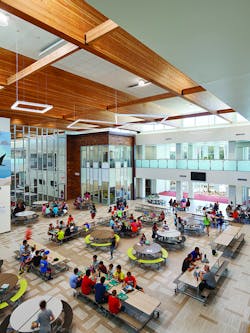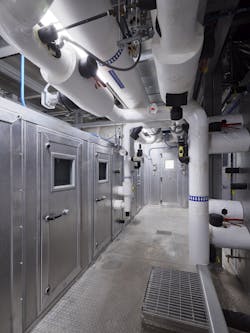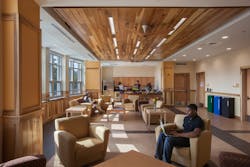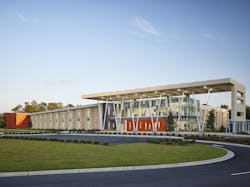Over the years, the commitment to sustainability and energy efficiency has been growing steadily among schools and universities, and the concept of green schools is familiar among administrators and designers.
In December, the U.S. Green Building Council announced that the number of K-12 school facilities that have received LEED certification for environmentally friendly design and construction has surpassed 2,000.
An emphasis on reducing energy consumption is a laudable and widely accepted goal, but many education institutions are aiming higher in their quest for green facilities.
They recognize that as they construct and operate facilities, their efforts to conserve resources and reduce their carbon footprint can go much further.
Green living
An emphasis on sustainable strategies has become a fundamental part of planning a new school facility for many designers.
At the Hastings+Chivetta architectural firm, eco-charrettes are among the first steps in developing a design for a new educational facility, says Leslie Garner, the firm’s sustainability facilitator.
“We bring in all the stakeholders, including students, and go over sustainable design strategies and find out what they think,” says Garner. “We try to engage them and bring them into the prices.
Such sessions result in projects such as the appropriately named Deep Green Residence Hall at Berea College in Berea, Ky. The 42,000-square-foot, three-story facility houses about 120 students. When it received LEED platinum certification in 2014, its score of 90 points made it the highest-scoring LEED-certified residence hall in the world.The hall also has earned Living Building Challenge Petal Certification from the International Living Future Institute, which calls for the creation of buildings that operate as cleanly, beautifully and efficiently as a flower.
Deep Green’s sustainable elements include a solar panel array that produces 14 percent of the building’s annual energy usage; a geothermal system of 50 wells to provide heating and cooling; high-efficiency lighting fixtures; daylighting; ceiling fans; rain gardens; the use of brick manufactured with 100 percent recycled materials; a heat-reflective roof; and high-efficiency windows.
A less conventional sustainability effort is the 267 pieces of furniture that outfit the residence hall. They were made by Berea students with wood that was harvested by mule teams in the college’s forest so as to avoid the pollution that would have been generated by heavy machinery, long-distance transportation, and factory manufacturing.
For prospective students to whom sustainability is an important principle, such projects can make the difference when they choose where to attend college
“Schools are using sustainability as a recruiting tool to draw students to their campuses,” says Garner.
Zeroing in
One of the simple precepts of the environmental movement is reducing energy use. The closer to zero, the better.
So the concept of net zero energy—generating enough energy to offset what is consumed—is one that would appeal to those who believe conservation and preserving the environment are vital. Improvements in energy-saving techniques and strategies have made it less difficult to build net zero energy school facilities.
“Energy efficiency and renewable energy technology is changing rapidly and what did not make sense financially or technically a few years ago is feasible today,” says Achieving Zero Energy, a design guide for K-12 schoolspublished earlier this year by American Society of Heating, Refrigeration, and Air Conditioning (ASHRAE).
K-12 buildings make up a sizeable portion of the facilities designed to be net zero energy. A 2018 report from the New Buildings Institute identifies 482 net zero energy commercial building projects; 178 or those, or 37 percent, are education facilities.
Because even the most energy-efficient schools need to consume some amount of energy to operate, a net-zero building also must have some way to generate renewable energy that offsets what is being consumed. The primary way for net zero energy schools to produce renewable energy is with solar panels.
But even school sites where solar panel installation or other renewable energy sources (e.g., wind power) are not feasible should be designed to have a low energy use intensity (EUI)—energy per square foot per year, the ASHRAE guide says.
“Achieving very low EUI is the primary goal, whether or not on-site renewable energy is a feasible goal in the near or long-term future of the facility,” the guide says.
A low EUI will enable a school building to achieve net zero energy in the future if a renewable energy source becomes feasible.
Positive outlook
If a building that consumes zero net energy is good, one that generates more energy than it uses is even better. A net positive energy building is one that combines significant reduction of energy use with the production of renewable energy that exceeds what the building consumes.
The Horry County (S.C.) school district was in the midst of plans in 2014 to build five schools in and around Myrtle Beach when the board decided to scrap its initial proposals for more traditionally built schools and seek bids for facilities that would be net energy positive.
The board subsequently chose Firstfloor Energy Positive to be the design-builder for all five schools. The plan called for the five campuses—three middle schools, an intermediate school, and an elementary school—to be net energy positive.
“You save on operating costs over the lifetime of the buildings,” says Robbie Ferris, CEO of Firstfloor and its sister design firm, sfL+a Architects. “You spend more on capital costs that result in a more energy-efficient facility.”
Three of the schools—Socastee Elementary, St. James Intermediate, and Ten Oaks Middle—opened in August 2017. Myrtle Beach Middle opened in January 2018. Socastee Middle School is nearly completed, but the district is not expected to open the campus until 2018-19.
Although two of the schools were not ready to open in 2017 as originally projected, Ferris says building all five campuses at the same time cost less than it would have if they had been constructed over several years as the district had initially proposed.
“The interest rate for borrowing was lower than inflation,” Ferris says. “It would have cost them a lot more to wait.”
In addition, building the five campuses simultaneously enabled Firstfloor to take advantage of economies of scale.
“It provides better purchasing power and opportunities for cost reductions,” Ferris says.
All of the schools have numerous building elements so that the facilities expend much less energy than a traditionally designed campus. Those include geothermal systems for heating and cooling; LED lighting; enhanced building automation; an air-cleaning system that reduces the amount of outside air that needs to be brought into the building; and hollow-core concrete floor planks that store heated and cooled air and enable the facility to have smaller mechanical systems to generate heating and cooling.
Those elements make it possible for the schools to slash their energy consumption. To achieve net positive energy status, the buildings must generate energy on site. The key to doing that is installing an extensive array of photovoltaic panels to convert the sun’s rays to solar energy.
“We have solar panels on just about every square foot of roof,” Ferris says. “We also have some on the ground at one of the buildings with less roof area.”
In his initial pitch to Horry County, Ferris told the board that Firstfloor could build schools that would generate 40 percent more energy than they consumed. That estimate was based on the results produced at Sandy Grove Middle School in Hoke County, N.C., a facility designed by sfL+a that opened in 2013.
The energy production called for in the requests for proposals that the district ultimately sent out did not aim that high, Ferris says, so Firstfloor’s plans call for a positive energy generation of about 10 percent.
“It’s a question of how far do you go with energy positive,” Ferris says. “Sandy Grove is at about 40 percent. The Horry County schools are around 10 percent.”
Another Firstfloor school project under construction in Jones County, N.C., is aiming to have energy positive production of as much as 80 percent, Ferris says.
With four of the five Horry County schools now open, the question to be answered is whether the buildings will deliver on their promised energy performance. To get a clear picture of the peaks and valleys of energy use that accounts for differences in seasons, a full year of usage is needed.
In addition, Ferris says, as Firstfloor gets more precise data about building energy usage, it will be able to adjust systems such as the hollow-core floor storage and demand limiting sequences to optimize energy performance. The Horry County district has given the firm three years to make needed adjustments to deliver positive energy.
The schools are designed to produce a net energy positive of about 10 percent, but the actual requirement is for the facilities to generate at least one kilowatt hour more than they consume.
One obstacle for positive energy facilities, Ferris says, is that utility companies have different policies about whether they will purchase surplus energy from schools and how much they will pay.
“Net positive energy is definitely catching on, but it would catch on more if there were more consistent policies from utilities,” Ferris says. “As utilities see the benefits to them it will become more widespread.”
Although most of the focus of the Horry County projects is on the schools’ energy performance, Ferris emphasizes that other design elements in the buildings make the schools student-centered learning spaces that embrace modern education strategies.
“We could have done a double-loaded corridor school that was energy positive, but it wouldn’t have met the needs of a 21st-century environment,” says Ferris.
The design of the new schools also has made many of the students attending them converts to sustainability.
“Students learn about the building and become stewards of the built environment,” says Ferris. “It’s not just a place to learn in, it’s a place you learn from.”
About the Author
Mike Kennedy
Senior Editor
Mike Kennedy, senior editor, has written for AS&U on a wide range of educational issues since 1999.



